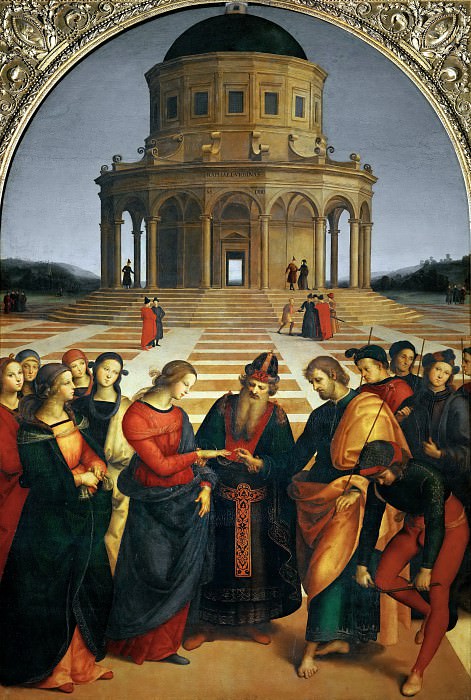Marriage of the Virgin Raphael (1483-1520)
Raphael – Marriage of the Virgin
Edit attribution
Download full size: 2756×4100 px (3,7 Mb)
Painter: Raphael
Location: Pinacoteca di Brera, Milano.
The panel The Betrothal of the Virgin Mary was commissioned especially for St. Joseph’s Chapel. According to scholars, Raphael was inspired by two compositions created by his direct teacher, Perugino. Raphael indicated directly on the temple depicted with his own name as well as the date. It captures that historical moment when Joseph puts a ring on Mary’s finger. In his hands we can see the staff, which is a symbol of election.
Description of Raphael Santi’s painting The Betrothal of the Virgin Mary
The panel The Betrothal of the Virgin Mary was commissioned especially for St. Joseph’s Chapel.
According to scholars, Raphael was inspired by two compositions created by his direct teacher, Perugino.
Raphael indicated directly on the temple depicted with his own name as well as the date. It captures that historical moment when Joseph puts a ring on Mary’s finger. In his hands we can see the staff, which is a symbol of election. It is noteworthy that it blossomed on him, whereas it did not on the others. We see two people who are disappointed and break the staffs.
The structure of the composition is created by the polygonal temple. It dominates everything. It is the temple that determines how all the figures and the main group in the foreground of this painting are arranged. The painter creates a particular radial system with the temple as the center. As the viewer looks into the distance through the numerous arcades and doorways, he has the impression that this system has a quite logical continuation on the other side of this majestic building.
The composition has a circular structure. This rhythm is repeated by the group of guests at this wedding.
As for the color scheme, it is worth noting that mainly used brownish and golden tones with some inclusions of other colors. The figures of all the characters in the picture are very light. It seems as if they are in a very pure atmosphere. Its creation is greatly helped by the light blue sky.
The structure of Raphael’s creation is very similar to the work of his teacher Perugino. In contrast to the horizontal composition, Raphael’s has a circular structure. It is this particular composition with the polygonal building and the group of figures that absolutely distinguishes Raphael’s work from the works of his teacher. The entire space in the artist’s painting is more open, and the perspective itself is depicted with the greatest skill.
Кому понравилось
Пожалуйста, подождите
На эту операцию может потребоваться несколько секунд.
Информация появится в новом окне,
если открытие новых окон не запрещено в настройках вашего браузера.
You need to login
Для работы с коллекциями – пожалуйста, войдите в аккаунт (open in new window).
















COMMENTS: 3 Ответы
прикол
В картине изображен эпизод, описанный в Новом Завете, – обручение Марии и Иосифа. Пожилой человек в центре картины – это священник, совершающий акт обручения; юноши и девушки по сторонам от него – “конкуренты” жениха и подруги невесты…Юноша на переднем плане ломает о колено свой посох, расстроенный тем, что он процвел у Иосифа, а не у него…Согласно легенде, именно так был отмечен человек, удостоенный чести стать земным родителем Христа.
По художественному совершенству это одно из величайших творений итальянского Возрождения; Рафаэлю в период создания картины было немногим более двадцати лет.
Центрическое здание на заднем плане – результат длительных поисков архитектурной гармонии и симметрии, в равной степени присущих церкви Сан-Пьетро ин Монторио (Темпьетто) архитектора Донато Браманте – друга и земляка Рафаэля.
Мария Карла Претте, Альфонсо де Джоржис “Как понимать искусство”
э... а я думал иисус сын божий а тут и батя и мама человеки
You cannot comment Why?
Behind the main group, a grand, octagonal temple with a dome stands majestically, serving as the backdrop for the event. The temples intricate architecture, with its colonnades and steps, creates a sense of depth and grandeur. Figures are scattered across the temples plaza, some engaged in conversation, others observing the ceremony. The scene is set against a serene, pale blue sky, with distant hills visible on the horizon.
The painting is rich in subtext and symbolism. The central event, the Marriage of the Virgin, signifies purity, divine union, and the commencement of a holy lineage. The temple, a Renaissance interpretation of a classical building, represents perfection, order, and the sacred space where such a momentous event takes place. Its circular form can symbolize eternity and unity. The meticulously rendered architecture also reflects the Renaissance ideals of symmetry, harmony, and mathematical precision.
The crowd surrounding Mary and Joseph is divided, with women on Marys side and men on Josephs, highlighting the traditional assembling of families for a wedding. A key subtext is found in the broken rod held by a man beneath Joseph. According to tradition, Joseph was chosen from a group of suitors, each given a rod to hold; only Josephs rod bloomed, signifying his divine selection. The broken rod of another suitor represents his rejection. This detail not only clarifies Josephs eligibility but also underscores the divine intervention and destiny guiding the union. The overall composition, with its balanced arrangement and clear perspective, emphasizes the harmony and divine order of the event.